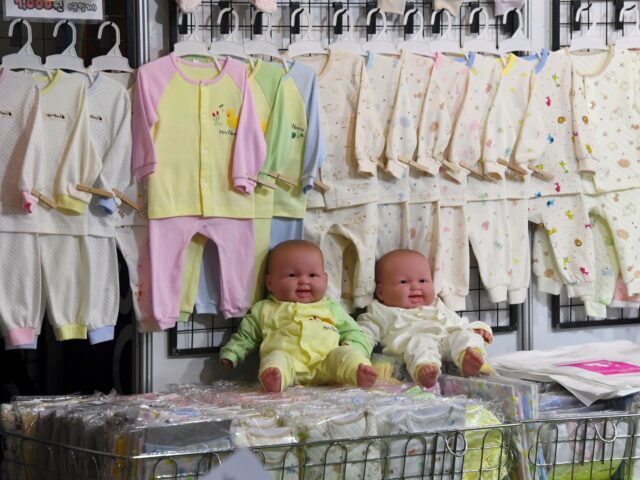South Korean pediatricians are exiting the profession as birth rates decline, creating a hospital environment where few children are being born, but there still are not enough doctors to care for them.
South Korea’s fertility rate fell to 0.78 per woman in 2022, the lowest in the world – a distinction South Korea has held since 2013, even as almost every industrialized nation grapples with demographic decline.
Japan, often cited as the world’s most formidable example of demographic collapse, currently has a fertility rate of 1.3. Japan has an even worse problem than South Korea with its population aging or “graying,” as older people live longer but fewer young people rise to replace them in the workforce.
The birthrate decline in South Korea has been accompanied by a rapid exodus of doctors from pediatrics and moving into booming specialties like psychiatry and anesthesiology. Reuters noted on Thursday that this trend was accelerated by the South Korean health insurance system, which left the payment schedules for pediatrics untouched for over 30 years while inflation rose and the number of patients declined.
This sent a rather unmistakable signal to young doctors that pediatrics would not be a vibrant career path to pursue. It also left hospitals unable to sustain their pediatric units, as fewer patients plus lower payments per patient equaled fiscal disaster. One South Korean doctor noted that his country’s insurance plans are paying about $10 per treatment, compared to more like $200 in the U.S. and other advanced economies, which means South Korea’s hospitals are receiving less than a quarter of the income stream they need.
The situation has become so dire that young South Korean couples say the shortage of pediatric care is making them more reluctant to have children, further accelerating the downward demographic spiral.

File/This picture taken on December 21, 2017 shows baby bonnets displayed on a booth at a baby fair in Seoul. Rapid economic growth over several decades has seen South Korea’s GDP boom, but birth rates have gone in the opposite direction. ( JUNG YEON-JE/AFP via Getty Images)
Reuters quoted South Korean parents who said they have to wait weeks before seeing a doctor, even when their children have serious illnesses, and hospitals that said they can fill less than 20 percent of the pediatric positions they need.
Two recent hospital tragedies involving young people horrified and angered the South Korean public. The first occurred in March, when a 17-year-old girl fell from a four-story building and suffered a head injury. The girl was shuttled between four different hospitals over the course of two agonizing hours, only to be turned away by each because the necessary specialists or bed space were unavailable. The patient suffered a cardiac arrest and died after the fourth hospital refused to treat her, as her ambulance team frantically called every hospital and clinic in the city of Daegu in a doomed effort to find a bed for her.
In May, a five-year-old boy who was experiencing severe breathing difficulty died in Seoul after four different hospitals said they had no beds or pediatric doctors available. A fifth hospital could do no more than quickly shuffle the child through ineffective outpatient treatment for bronchitis.
Dr. Song Dae-jin of Korea University Guro Hospital said his pediatric team “won’t be able to last the year” if staff shortages continue.
“It’s not a big deal if mild diseases are not seen for a day or two but the consequences of not seeing serious diseases or emergency patients in a timely manner can be devastating,” Song warned.
“Patients dying while bouncing around multiple emergency rooms, dying when it’s not a serious disease, it’s a travesty,” added Dr. Choi Yong-jae, vice-president of the Korea Children’s Hospital Association.
Reuters noted that some South Korean hospitals have eliminated night shifts or shut down their children’s emergency rooms entirely. The oldest children’s hospital in the country, Sowha Hospital, suspended Saturday and Sunday treatment hours for the first time in 77 years of operation due to insufficient staff.
NPR suggested there are “lessons for us all” in South Korea’s fertility crisis. One of those lessons is that big government spending programs to subsidize the cost of bearing and raising children – the preferred strategy of most governments for reversing demographic decline – do not work very well, not when the downward pressure on fertility from rising costs of living and collapsing marriage rates is so powerful:
South Korea has invested heavily to stem what is now a seven-year decline in the national fertility rate, but it hasn’t made much difference. President Yoon Suk Yeol said in September that the government has poured more than $200 billion into programs to support new mothers in the past 16 years alone, only to watch the fertility rate drop more than 25% in that time span.
At the center of the government response is a pledge to increase the stipend given to parents with a child under the age of 1 from 300,000 won per month (about $230) to 1 million won ($765) by 2024.
The country’s child care policies are also among the best in the world, according to UNICEF, and continue to expand. The government announced plans in January to increase the paid parental leave period from one year to a year-and-a-half. The U.S., by comparison, has no national paid leave plan, and only about 35% of workers are employed at companies that offer any paid parental leave.
And yet, South Korea has a much worse fertility crisis than the United States, in part because couples cannot afford housing in the big cities while pursuing their careers, and ambitious young workers are worried about the demands of parenthood cutting into the long hours they put in at the office, a mindset critics describe as “workism.”
South Korea has extremely low rates of out-of-wedlock birth, so the decline of marriage correlates even more directly to demographic collapse than in other nations. Young South Koreans, especially women, view marriage and parenthood as unaffordable and illogical as they struggle to get careers off the ground in a highly competitive professional environment.
Even as the number of children dwindles and the crisis of plunging fertility rates grows more painfully obvious, public support for “no-child zones” has grown. Stated simply, the public does not want to be reminded about its shortage of children, but by easily avoiding contact with other people’s kids, couples feel even less motivated to have children of their own.
Economist Lyman Stone ruefully noted to NPR that South Korea “successfully achieved some of the fastest economic growth in human history, and the price has been that there isn’t a next generation to inherit it.”

COMMENTS
Please let us know if you're having issues with commenting.